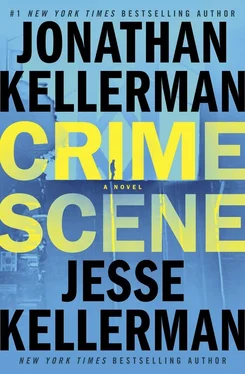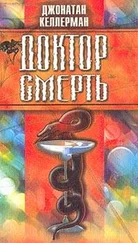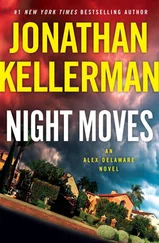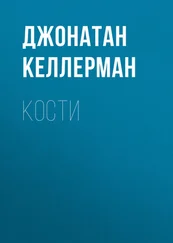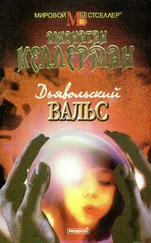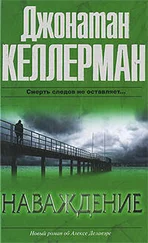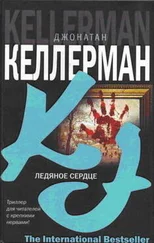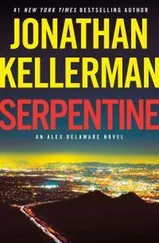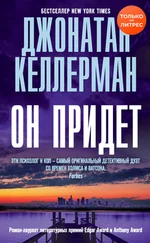It was getting harder and harder not to make assumptions.
Pincered in Rennert’s left hand was an item that, for me, is almost always the single best piece of evidence: a cellphone. People keep their whole lives on their phones. You’d be amazed at how many of them will google signs of a heart attack instead of calling 911.
Rennert’s was a scratched black iPhone, three or four versions old.
Zaragoza photographed the front side of the body.
When he finished, I examined Rennert’s cheekbones, forehead, jaw, sternum, and rib cage. I freed the phone and gave it to Zaragoza to catalog, concluding with a check of the extremities before heading outside to confer with Schickman.
“We’ll hang on to his cell for now,” I said. “If you need something let me know.”
“Right on.”
“We’re just gonna have a quick look around the house.”
Schickman nodded. He look relaxed. He was making assumptions, too.
It’s the mark of a good secondary when you don’t have to waste time negotiating the division of labor. Zaragoza might be a neurotic hypochondriac, but he’s a professional: he’d taken it upon himself to cover the ground floor, leaving me the upstairs. I followed on his sweep of the staircase with one of my own, failing to find any evidence pointing to a fall or a fight.
Mostly I wanted to track down the hypertension medication. Say Rennert had missed a bunch of pills. That could point toward a natural death: a stroke, for example. Taking too many pills could lead to light-headedness, which in turn could lead to fainting.
A person’s home is also a useful indicator of whether he’s taking care of himself, sleeping well, getting proper nutrition, and so on.
In this instance, I got mixed signals. Each of the five bedrooms was tidy and tastefully decorated but gave off a stale, unused odor.
In the master I paused to take in a panoramic view of the Bay.
The medicine cabinet in the master bath was empty. Dust dulled the tub.
Rennert was divorced. Maybe he slept somewhere else because the suite conjured too many unpleasant memories. Or it felt overlarge for a single man, living alone.
Nothing hinted at the existence of a girlfriend. No women’s clothes in the closet, no stray pots of makeup. Here and there amid the art hung family photos, various combinations of the same three faces, at various stages of childhood and adolescence: Tatiana and two boys roughly ten years older. Products of a previous marriage, perhaps. I saw them apple-cheeked in ski suits against a backdrop of regal pines; holding hands as they jumped into a swimming pool; riding horses in tall dry grass. They looked happy. If they were in fact stepsiblings, they appeared to have blended well enough.
Then again, you don’t whip out the camera when the kids are fighting.
Figuring Rennert for one of those people who keep their medicines by the kitchen sink, I started down the hall, pausing by a narrow door.
I had overlooked it, thinking — assuming — it was a linen closet.
I opened it and instead peered up a cramped second staircase.
As I mounted the steps, a phantom ache stirred in my knee, and I stopped for a moment, gripping the banister, breathing through my teeth.
I climbed on.
The staircase opened to an attic, plywood floors and naked rafters and bulging insulation. Stifling and dark, it ran the length of the second story, lacking interior walls but sectioned by Oriental rugs and file cabinets, lamps and books and odd bits of junk. A comfortable disorder that conveyed movement and intention, unlike the space below.
A monumental kneehole desk, ornately carved and piled high with books and magazines, anchored one zone. There was no desk chair, but rather a pair of chairs set up to face each other. The first was a lounger that looked like it had been slept in a lot: nubby upholstery, blanket limp over the arm, grimy buckwheat neck pillow. The second chair was a wooden rocker with smooth, carved spindles, a rich red cherry stain. The two pieces made for strange companions — one elegant and cool, the other greasy and creased. They seemed to huddle in conversation; they looked like a dude on a bender and his successful younger brother, there to stage an intervention. Yet again.
Along the far wall I spied the components of a basic bathroom: plastic-basin shower, sink, toilet, exposed plumbing.
I’d found where Rennert did his living.
No fridge. Maybe he still went downstairs to eat.
I picked my way through the gloom toward the sink.
No pill bottles.
I got down to check the floor.
I inched back the shower curtain.
The makeshift sleeping area felt like the next most logical place to look.
I made my way there, high-stepping over milk crates filled with LPs, sliding aside the rocking chair to stand before the desk.
I wondered how they’d gotten the massive thing up those stairs. A crane? The largest window, overlooking the Bay, didn’t look big enough to admit it. Maybe it had been taken apart plank by plank and reassembled onsite, imprisoned, never to leave.
As a symbol, it felt kind of over the top.
One glance at the mess of papers smothering the desktop was enough to generate a strong hypothesis about Walter Rennert’s profession. Books: The Teenage Brain and Taming the Human Animal and Issues in Contemporary Research Design. Academic journals: Assessment. Adolescence and Childhood Quarterly. Personality and Social Psychology Bulletin.
It fit. We weren’t far from campus. Although I’d majored in psych, and I didn’t recognize his name.
Hospital or private practice?
Maybe he used the attic as his office, put his patients in the lounger and took notes in the rocker. To me it didn’t feel like a relaxing place to unburden oneself. Too claustrophobic. But to each his own.
I started opening the column of desk drawers on the right.
Pens, pencils, checkbooks, bills, bank statements, invoices, Post-its, confetti, crap.
Middle right, more of the same.
Bottom right, a .38 Smith & Wesson revolver.
As a rule, we stick to a single camera per scene. It gets too confusing otherwise, having to coordinate different devices. Zaragoza had the Nikon with him downstairs. For the moment I used my own phone to shoot a few flicks, not so much for the official record as to remind myself.
The mere presence of a weapon did not raise red flags. People own guns. Even people in Berkeley. More to the point, Rennert hadn’t been shot.
I checked the cylinder.
Five-round capacity.
Four cartridges, full metal jacket.
The central drawer contained more paper and unopened mail.
The drawers on the left were false, a single door that swung out to reveal a deep cabinet, stuffed with a splendid array of fine scotch whiskeys: Walter Rennert’s liquid pantry.
At least I think the whiskeys were fine. I don’t know booze. They had fancy labels with pictures of game animals and dramatic Highland names.
At any rate, they had all been well enjoyed.
Three tumblers, identical to the one I’d found in Rennert’s hand, sat in a rack on the inside of the cabinet door. Tucked into the tumblers were three plastic amber pill bottles.
The first two contained a diuretic and a beta-blocker — as expected, with Rennert being treated for hypertension. I noted the dates, the dosages, the prescribing doctor (Gerald Clark, MD). A count of the pills corresponded to the days remaining before refill.
The third prescription had been issued by a different doctor, Louis Vannen, and filled five days earlier at a different pharmacy.
We don’t receive any formal medical or pharmacological training, but along the way you pick up the basics. Rennert’s third prescription was for Risperdal, which is the brand name for risperidone, which is a widely used antipsychotic.
Читать дальше
